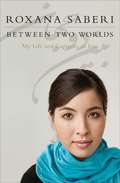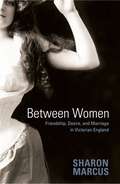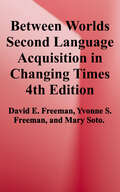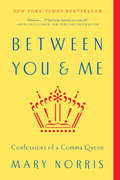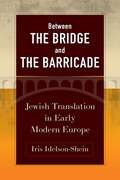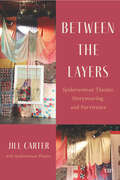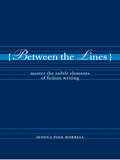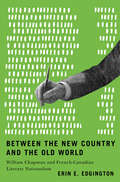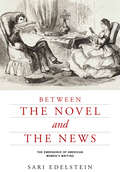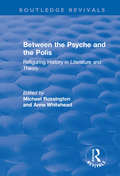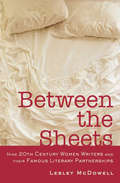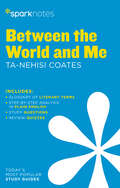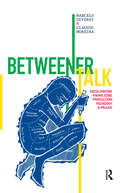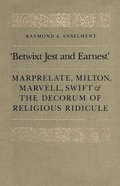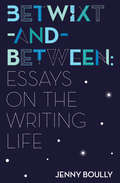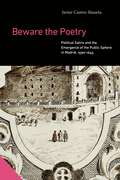- Table View
- List View
Between Two Worlds: My Life and Captivity in Iran
by Roxana SaberiA chronicle of the Iranian-American journalist's imprisonment, as well as a look at Iran and its political tensions.
Between Women: Friendship, Desire, and Marriage in Victorian England
by Sharon MarcusWomen in Victorian England wore jewelry made from each other's hair and wrote poems celebrating decades of friendship. They pored over magazines that described the dangerous pleasures of corporal punishment. A few had sexual relationships with each other, exchanged rings and vows, willed each other property, and lived together in long-term partnerships described as marriages. But, as Sharon Marcus shows, these women were not seen as gender outlaws. Their desires were fanned by consumer culture, and their friendships and unions were accepted and even encouraged by family, society, and church. Far from being sexless angels defined only by male desires, Victorian women openly enjoyed looking at and even dominating other women. Their friendships helped realize the ideal of companionate love between men and women celebrated by novels, and their unions influenced politicians and social thinkers to reform marriage law. Through a close examination of literature, memoirs, letters, domestic magazines, and political debates, Marcus reveals how relationships between women were a crucial component of femininity. Deeply researched, powerfully argued, and filled with original readings of familiar and surprising sources, Between Women overturns everything we thought we knew about Victorian women and the history of marriage and family life. It offers a new paradigm for theorizing gender and sexuality--not just in the Victorian period, but in our own.
Between Worlds
by William PallisterJohn Milton's Paradise Lost has long been celebrated for its epic subject matter and the poet's rhetorical fireworks. In Between Worlds, William Pallister analyses the rhetorical methods that Milton uses throughout the poem and examines the effects of the three distinct rhetorical registers observed in each of the poem's major settings: Heaven, Hell, and Paradise.Providing insights into Milton's relationship with the history of rhetoric as well as rhetorical conventions and traditions, this rigorous study shows how rhetorical forms are used to highlight and enhance some of the poem's most important themes including free will, contingency and probability. Pallister also provides an authoritative discussion of how the omniscience of God in Paradise Lost affects Milton's verse, and considers how God's speech applies to the concept of the perfect rhetorician.An erudite and detailed study of both Paradise Lost and the history of rhetoric, Between Worlds is essential reading that will help to unravel many of the complexities of Milton's enduring masterpiece.
Between Worlds: Second Language Acquisition in Changing Times
by Yvonne S. Freeman David E. Freeman Mary SotoLong considered a groundbreaking text for pre-service, in-service, mainstream, and EL teachers, the bestselling Between Worlds is now available in an updated Fourth Edition. <p><p>As student populations across the U.S. reflect increasing racial, ethnic, and linguistic diversity in changing times, the need for effective, research-based classroom practices has never been greater. The Fourth Edition includes what you need to effectively provide equitable instruction for emergent bilingual students including: <p>- How to implement activities/strategies for in class, online, and hybrid settings <p>- How to address racial/social justice issues <p>- How to respond to immigrant student concerns in the current political climate <p>- How to incorporate students' home languages through translanguaging. <p><p>Ever mindful of the needs of teachers in a range of settings, Freemans and Soto include new classroom vignettes and case studies of teachers and students to illustrate what best-practice second language acquisition instruction looks like in today's schools.
Between You & Me: Confessions of a Comma Queen
by Mary Norris"Hilarious. . . . This book charmed my socks off." --Patricia O'Conner, New York Times Book Review Mary Norris has spent more than three decades in The New Yorker's copy department, maintaining its celebrated high standards. Now she brings her vast experience, good cheer, and finely sharpened pencils to help the rest of us in a boisterous language book as full of life as it is of practical advice. Between You & Me features Norris's laugh-out-loud descriptions of some of the most common and vexing problems in spelling, punctuation, and usage--comma faults, danglers, "who" vs. "whom," "that" vs. "which," compound words, gender-neutral language--and her clear explanations of how to handle them. Down-to-earth and always open-minded, she draws on examples from Charles Dickens, Emily Dickinson, Henry James, and the Lord's Prayer, as well as from The Honeymooners, The Simpsons, David Foster Wallace, and Gillian Flynn. She takes us to see a copy of Noah Webster's groundbreaking Blue-Back Speller, on a quest to find out who put the hyphen in Moby-Dick, on a pilgrimage to the world's only pencil-sharpener museum, and inside the hallowed halls of The New Yorker and her work with such celebrated writers as Pauline Kael, Philip Roth, and George Saunders. Readers--and writers--will find in Norris neither a scold nor a softie but a wise and witty new friend in love with language and alive to the glories of its use in America, even in the age of autocorrect and spell-check. As Norris writes, "The dictionary is a wonderful thing, but you can't let it push you around."
Between You & Me: Confessions of a Comma Queen
by Mary NorrisThe most irreverent and helpful book on language since the #1 New York Times bestseller Eats, Shoots & Leaves. Mary Norris has spent more than three decades in The New Yorker's copy department, maintaining its celebrated high standards. Now she brings her vast experience, good cheer, and finely sharpened pencils to help the rest of us in a boisterous language book as full of life as it is of practical advice. Between You & Me features Norris's laugh-out-loud descriptions of some of the most common and vexing problems in spelling, punctuation, and usage--comma faults, danglers, "who" vs. "whom," "that" vs. "which," compound words, gender-neutral language--and her clear explanations of how to handle them. Down-to-earth and always open-minded, she draws on examples from Charles Dickens, Emily Dickinson, Henry James, and the Lord's Prayer, as well as from The Honeymooners, The Simpsons, David Foster Wallace, and Gillian Flynn. She takes us to see a copy of Noah Webster's groundbreaking Blue-Back Speller, on a quest to find out who put the hyphen in Moby-Dick, on a pilgrimage to the world's only pencil-sharpener museum, and inside the hallowed halls of The New Yorker and her work with such celebrated writers as Pauline Kael, Philip Roth, and George Saunders. Readers--and writers--will find in Norris neither a scold nor a softie but a wise and witty new friend in love with language and alive to the glories of its use in America, even in the age of autocorrect and spell-check. As Norris writes, "The dictionary is a wonderful thing, but you can't let it push you around."
Between You & Me: Confessions of a Comma Queen
by Mary NorrisMary Norris has spent more than three decades in The New Yorker's copy department, maintaining its celebrated high standards. Now she brings her vast experience, good cheer, and finely sharpened pencils to help the rest of us in a boisterous language book as full of life as it is of practical advice.<P><P> Between You & Me features Norris's laugh-out-loud descriptions of some of the most common and vexing problems in spelling, punctuation, and usage--comma faults, danglers, "who" vs. "whom," "that" vs. "which," compound words, gender-neutral language--and her clear explanations of how to handle them. Down-to-earth and always open-minded, she draws on examples from Charles Dickens, Emily Dickinson, Henry James, and the Lord's Prayer, as well as from The Honeymooners, The Simpsons, David Foster Wallace, and Gillian Flynn. She takes us to see a copy of Noah Webster's groundbreaking Blue-Back Speller, on a quest to find out who put the hyphen in Moby-Dick, on a pilgrimage to the world's only pencil-sharpener museum, and inside the hallowed halls of The New Yorker and her work with such celebrated writers as Pauline Kael, Philip Roth, and George Saunders.<P> Readers--and writers--will find in Norris neither a scold nor a softie but a wise and witty new friend in love with language and alive to the glories of its use in America, even in the age of autocorrect and spell-check. As Norris writes, "The dictionary is a wonderful thing, but you can't let it push you around. "
Between the Angle and the Curve: Mapping Gender, Race, Space, and Identity in Willa Cather and Toni Morrison (Literary Criticism and Cultural Theory)
by Danielle RussellIn this study, Russell explores the ways in which Willa Cather and Toni Morrison subvert the textual expectations of gendered geography and push against the boundaries of the official canon. As Russell demonstrates, the unique depictions Cather and Morrison create of the American landscape challenge existing assertions about American fiction. Specifically, Russell argues that looking at the intimate connections between space, gender, race, and identity as they play out in the fiction of Cather and Morrison refutes the myth of a unified American landscape and thus opens up the territory of American fiction.
Between the Bridge and the Barricade: Jewish Translation in Early Modern Europe (Jewish Culture and Contexts)
by Iris Idelson-SheinBetween the Bridge and the Barricade explores how translations of non-Jewish texts into Jewish languages impacted Jewish culture, literature, and history from the sixteenth century into modern times. Offering a comprehensive view of early modern Jewish translation, Iris Idelson-Shein charts major paths of textual migration from non-Jewish to Jewish literatures, analyzes translators’ motives, and identifies the translational norms distinctive to Jewish translation. Through an analysis of translations hosted in the Jewish Translation and Cultural Transfer (JEWTACT) database, Idelson-Shein reveals for the first time the liberal translational norms that allowed for early modern Jewish translators to make intensely creative and radical departures from the source texts—from “Judaizing” names, places, motifs, and language to mistranslating and omitting material both deliberately and accidently. Through this process of translation, Jewish translators created a new library of works that closely corresponded with the surrounding majority cultures yet was uniquely Jewish in character.As a site of intense negotiation between different cultures, communities, religions, readers, genres, and languages, these translations become an ideal entry point into the complex relationships between early modern Christians and Jews. At the same time, they also pose a significant challenge for modern-day scholars. But, for the careful reader, who can navigate the labyrinth of unacknowledged translations of non-Jewish sources into Jewish languages, there awaits a terrain of surprising intercultural encounters between Jews and Christians. Between the Bridge and the Barricade uncovers the hitherto hidden non-Jewish corpus that, Idelson-Shein contends, played a decisive role in shaping early modern Jewish culture.
Between the Layers: Spiderwoman Theatre, Storyweaving, and Survivance
by Jill CarterThe Spiderwoman Theatre, the longest-running Indigenous theatre company in North America has heralded the revolutionary methodology of Storyweaving for generations of Indigenous artists. Storyweaving is a distinct methodology that governs the dramaturgical structure and performed transmission of the company’s plays on the contemporary stage. The practice of Storyweaving predates written history. It has been (and remains) specific to tribal storytellers across the continent. The reclamation, then, of this aesthetic legacy by contemporary Indigenous storytellers is a crucial act of recovery. Jill Carter, an Anishinaabe-Ashkenazi theatre-worker and scholar, examines the process and development of Storyweaving. She studies how Storyweaving imagines and architects a functional framework that is being adopted and adapted by artists from myriad nations to create works (on the page and stage) that facilitate the healing, transformation, and survivance of their communities. Between the Layers pays respects to the teachers and visionaries that moulded this practice and encourages future generations to continue its legacy, while making a much-needed contribution to the study of Indigenous theatre and performance. In its painstaking documentation of the Storyweaving artform, Between the Layers refuses the devaluation, erasure, and suppression of Indigenous culture, while contributing to the dissemination and celebration of Indigenous Knowledge Systems.
Between the Lines: Master the Subtle Elements of Fiction Writing
by Jessica Page MorrellEffective storytelling stems from many elements, the most crucial of which are unseen or blended in so unobtrusively that they are difficult to spot and analyze. Still, they are necessary to the wholeness and coherence of a story–to create a work that lingers and resonates in the reader's imagination. In Between the Lines, author and writing instructor Jessica Page Morrell shows you how to craft a unified and layered novel or short story by mastering subtle storytelling techniques, such as: Using emotional bombshells, surprises, and interruptions to intensify cliffhangers Enlarging your story world through the use of layered subplots Building suspense one scene at a time to maximize the emotional payoff Anchoring your premise to your protagonist's character arc Transitioning into and out of flashbacks without interrupting the mood of your story Detailed instruction combined with examples from well-known authors turn seemingly complex topics like subtext, revelations, misdirection, and balance into comprehensible techniques that will elevate your writing to the next level.
Between the New Country and the Old World: William Chapman and French-Canadian Literary Nationalism
by Erin E. EdgingtonPoet and provocateur William Chapman (1850–1917) wrote patriotic verse recounting the history of New France, envisioning a glorious future for its descendants. Despite his many literary achievements – he was a two-time laureate of the Académie française and a nominee for the Nobel Prize in Literature – Chapman is more often remembered for his explosive feud with Louis Fréchette, a rivalry that pitted the two national poets against one another and played out in vicious invective across the pages of Quebec newspapers.Chapman’s lifelong quest to glorify French Canada and accumulate literary prestige in North America and Europe positioned him squarely between the new country and the old world. Over the course of his forty-year career, Chapman published five collections of poetry – Les Québecquoises (1876), Les Feuilles d’érable (1890), Les Aspirations (1904), Les Rayons du Nord (1909), and Les Fleurs de givre (1912) – whose very titles underscore his devotion to French-Canadian identity, as well as his literary ambition. Integrating close readings of Chapman’s verse with archival material related to his writing life, Erin Edgington revisits his full oeuvre on its own terms and in context, discerning the particular ways Chapman expressed the ideas of literary value and national literature that motivated him from a young age, from juvenilia like Les Mines d’or de la Beauce (1881) to his polemical essays and his unfinished magnum opus, L’Épopée canadienne.Between the New Country and the Old World challenges the prevailing narrative that has labelled Chapman a second-rate, forgettable poet, showing how his life and work reveal important insights into literary fame, poetics in a transitional moment at the turn of the century, and the history of French literature in North America.
Between the Novel and the News: The Emergence of American Women's Writing
by Sari EdelsteinWhile American literary history has long acknowledged the profound influence of journalism on canonical male writers, Sari Edelstein argues that American women writers were also influenced by a dynamic relationship with the mainstream press. From the early republic through the turn of the twentieth century, she offers a comprehensive reassessment of writers such as Catharine Maria Sedgwick, Harriet Jacobs, and Charlotte Perkins Gilman. Drawing on slave narratives, sentimental novels, and realist fiction, Edelstein examines how advances in journalism—including the emergence of the penny press, the rise of the story-paper, and the birth of eyewitness reportage—shaped not only a female literary tradition but also gender conventions themselves.Excluded from formal politics and lacking the vote, women writers were deft analysts of the prevalent tropes and aesthetic gestures of journalism, which they alternately relied upon and resisted in their efforts to influence public opinion and to intervene in political debates. Ultimately, Between the Novel and the News is a project of recovery that transforms our understanding of the genesis and the development of American women’s writing.
Between the Psyche and the Polis: Refiguring History in Literature and Theory (Routledge Revivals Ser.)
by Anne WhiteheadThis title was first published in 2000. Incorporating studies of Freudian and Marxist approaches to questions of history and memory, this timely collection illuminates how history is being refigured in contemporary literary, cultural and theoretical studies. The contributors to this volume invite the reader to attend to the forms - linguistic, visual, monumental - by which a connection with, or separation from, the past takes place. It is current thinking about memory's relationship to history, and the ongoing critical reassessment of historicism, that preoccupies this collection. The volume explores the ways in which current thinking about the past operates within a dialogic space and can be located in relation to multiple perspectives. Thus cultural memory can be seen not just as a recent development within the field of cultural studies, but as constructing a between-space which also draws in aspects of psychoanalysis. Similarly, trauma theory may usefully be conceptualized as operating in a rich and complex dynamic between deconstruction and the work of Freud. Temporality, memory and the past are attended to here in terms of the dislocations of narrative, of resistances to linear genealogies, to aid the reader in making unanticipated connections between theories and cultures, and between the demands of the psyche and the polis.
Between the Sheets: Nine 20th Century Women Writers and Their Famous Literary Partnerships
by Lesley McDowellThe literary critic examines the love lives and career ambitions of some of the twentieth century&’s greatest female authors—from Sylvia Plath to Anaïs Nin. Why did a gifted writer like Sylvia Plath stumble into a marriage that drove her to suicide? Why did Hilda Doolittle (H.D.) want to marry Ezra Pound when she was far more attracted to women? Why did Simone de Beauvoir pimp for Jean-Paul Sartre? In Between the Sheets, author and feminist scholar Lesley McDowell examines nine famously troubled literary romances to arrive at a provocative insight into the motivations of these and other great female writers. The list of the damages done in each of these sexual relationships is long, but each provokes the same question: would these women have become the writers they became without these relationships? Delving into their diaries, letters, and journals, McDowell examines the extent to which each woman was prepared to put artistic ambition before personal happiness, and how dependent on their male writing partners they felt themselves to be. &“McDowell . . . has culled incredibly juicy details. With so many affairs and broken hearts, the most surprising thing may be that anything got written in the last 100 years.&” —The New York Times Book Review
Between the World and Me SparkNotes Literature Guide (SparkNotes Literature Guide Series)
by SparkNotesCreated by Harvard students for students everywhere, SparkNotes give you just what you need to succeed in school: Complete Plot Summary and AnalysisKey Facts About the WorkAnalysis of Major CharactersThemes, Motifs, and SymbolsExplanation of Important QuotationsAuthor&’s Historical ContextSuggested Essay Topics25-Question Review QuizBetween the World and Me features explanations of key themes, motifs, and symbols including: the facade of the American dream; the destruction of the black body; violence; dreamers; the yard; Paris. It also includes detailed analysis of these important characters: Ta-Nehisi Coates; Samori Coates; Dr. Mable Jones; Kenyatta Matthews.
Betweener Talk: Decolonizing Knowledge Production, Pedagogy, and Praxis (Qualitative Inquiry and Social Justice)
by Marcelo Diversi Claudio MoreiraIn this literary, co-constructed narrative, two Brazilian scholars explore the spaces “in-between”—between their own biographies, one raised privileged, the other poor; between the experience of being raised in Brazil and finding acceptance in United States universities; between their lives in the academic establishment and their studies of poverty in Latin America; between the constraints of apolitical scholarship and the need to promote social justice; between contrasting styles of researching, theorizing, and writing. Their dialogue seeks to decolonize the world of American scholarship and promote the use of research toward inclusive social justice.
Betwixt Jest and Earnest: Marprelate, Milton, Marvell, Swift & the Decorum of Religious Ridicule
by Raymond A. AnselmentMarprelate, Milton, Marvell, and Swift are among the best prose satirists in a remarkably rich literary era. Focusing on these key figures, 'Betwixt Jest and Earnest' examines the theory and practice of religious prose in the sixteenth and seventeenth centuries. Recognizing the difficulties inherent in attempting to transform unimaginative animadversion into effective satire, it analyses the ways in which Marprelate's tracts, Milton's anti-prelatical satires, Marvell's The Rehearsal Transpros'd, and Swift's A Tale of a Tub variously resolve the decorum of religious satire. Although the study is not specifically an intellectual history or a rigid definition of religious attitudes towards jest, it does bring together basic symptoms of altering sensibilities in the period. Marprelate, Milton, Marvell, and Swift represent diverse religious dispositions, but they share a similar satiric vision. Each recognizes the central importance of manner, and all develop dramatic satire heavily dependent on character, an emphasis which often displaces the immediate issues contested, but never obscures the larger concerns the satirists pursue. Their preoccupations with the nature of tradition, their emphasis on the self, and their sensitivity to language reflect similar involvements in questions of certainty and absolutism. The virtues and abuses they find in such central questions are not unique to them or their time, but their emphases are, for they wrote in an age in which sensitive men could confront revolution and reaction with an assurance not easily attainable once that era had passed.
Betwixt-and-Between: Essays on the Writing Life
by Jenny Boully“Powerful” essays exploring the experience of the writer—and the nature of experience itself (MinneapolisStar-Tribune). Shortlisted for the 2018 Chicago Review of Books Award in Nonfiction Jenny Boully’s essays are ripe with romance and sensual pleasures, drawing connections between the digression, reflection, imagination, and experience that characterize falling in love as well as the life of a writer. Literary theory, philosophy, and linguistics rub up against memory, dreamscapes, and fancy—making the practice of writing a metaphor for the illusory nature of experience. Betwixt-and-Between is, in many ways, simply a book about how to live. “[Boully’s] prose is reminiscent of Lydia Davis’—spare, elliptical, unexpected—and sometimes, in her rhythmic cadences, of Gertrude Stein’s . . . Graceful meditations on love, loneliness, and the magic of words.” —Kirkus Reviews “Jenny Boully is a deeply weird writer—in the best way.” —Ander Monson
Beware the Poetry: Political Satire and the Emergence of a Public Sphere in Madrid, 1595–1643 (Interactions in the Early Modern Age)
by Javier Castro-IbasetaIn the early seventeenth century, Spanish rulers were confronted by an avalanche of political satires. Beware the Poetry shows how these poetic libels helped articulate an early form of the public sphere, profoundly transforming political culture.Exploring a rich trove of mostly anonymous satirical works, together with newsletters, sermons, and plays, Javier Castro-Ibaseta reconstructs the experiences of Madrilenians during the reigns of Philip III and Philip IV. Castro-Ibaseta proposes an original theory of political publics that corrects approaches that assume early modern Spain’s public sphere mirrored the politics of England or France. Instead, he shows that in Spain publicness was distinct because the satires—about the king’s favorite, and even about the king himself—were consumed for pleasure and entertainment. They did not create political communities or stir rebellious movements. Read diachronically, the long, continuous, evolving collection of satires reveals not just the opinions of the poets but something far more difficult to reconstruct: the shifting demands, interests, uncertainties, and worldviews of the audience—that is, the structure and dynamics of Madrid’s emerging public sphere. Applying an interdisciplinary approach of literary criticism and historical method, Beware the Poetry presents an exciting new take on politics and poetry during the period often referred to as the Spanish Decadence. It will be of special interest to scholars of early modern politics and Spanish literature and culture.
Beware!
by Bob RaczkaA cautionary tale using words made up of only the five letters in the title (B, E, W, A, and R). Can a bear and a bee become friends?Abe and Bree aren't supposed to get along. When they meet, they panic. Abe swats! Bree stings! Now they're both hurt. Together they figure out how to find friendship despite differences and preconceived notions. This rare-bear, wee-bee tale helps to create a web of understanding with unique language and a clever structure.
Beyond 1776: Globalizing the Cultures of the American Revolution
by Carine Lounissi Edward N. Simon Leonard von Von Morze Wyger R.E. Velema Miranda Green-Barteet Matthew P. Dziennik Therese-Marie Meyer Jeng-Guo ChenIn Beyond 1776, ten humanities scholars consider the American Revolution within a global framework. The foundation of the United States was deeply enmeshed with shifting alliances and multiple actors, with politics saturated by imaginative literature, and with ostensible bilateral negotiations that were, in fact, shaped by speculation about realignments in geopolitical power. To reanimate these intricate and often indirect connections, this volume uncovers the influences of people across disparate sites both during and after independence.The book centers first on the migration of ideas across the Atlantic, particularly among intellectuals and through print. In this section, scholars focus on how various European countries or cliques appropriate the Revolution to reanimate an array of national, local, or cosmopolitan affiliations. The essays in the second section articulate how revolutions fostered surprising exchanges in, for example the West Indies and in the first penal colonies of Australia, along the Celtic fringe and Pacific Rim, and in the vast territories through which goods circulated. Taken as a whole, this collection answers the persistent calls from scholars to move beyond the boundaries defined by the nation-state or periodization to rethink narratives of U.S. foundations. The contributors examine a range of texts, from novels and drama to diplomatic correspondence, letters of common sailors, political treatises, newspapers, accounting ledgers, naval records, and burial rituals (many from non-Anglophone sources). Beyond 1776 will appeal to scholars seeking to understand contact and exchange in the late eighteenth century. It indexes how different intellectuals in the period deployed the Revolution as a point of connection; follows the dispersal of print books, guns, slaves, and memorabilia; and evaluates literary responses to the new republic. The book puts in conversation scholars of literature, theater, history, modern languages, American studies, political science, transatlanticism, cultural studies, women’s studies, postcolonialism, and geography.Contributors: Jeng-Guo Chen, Academia Sinica, Taiwan * Matthew Dziennik, United States Naval Academy * Miranda Green-Barteet, University of Western Ontario * Carine Lounissi, Université de Rouen-Normandie * Therese-Marie Meyer, Martin-Luther-University of Halle- Wittenberg * Maria O’Malley, University of Nebraska, Kearney * Denys Van Renen, University of Nebraska, Kearney * Ed Simon, Bentley University * Wyger Velema, University of Amsterdam * Leonard von Morzé, University of Massachusetts, Boston
Beyond Autonomy in Eighteenth-Century British and German Aesthetics (Routledge Studies in Eighteenth-Century Philosophy)
by Karl AxelssonThis volume re-examines traditional interpretations of the rise of modern aesthetics in eighteenth-century Britain and Germany. It provides a new account that connects aesthetic experience with morality, science, and political society. In doing so, it challenges long-standing teleological narratives that emphasize disinterestedness and the separation of aesthetics from moral, cognitive, and political interests. The chapters are divided into three thematic parts. The chapters in Part I demonstrate the heteronomy of eighteenth-century British aesthetics. They chart the evolution of aesthetic concepts and discuss the ethical and political significance of the aesthetic theories of several key figures: namely, the third Earl of Shaftesbury, David Hume, and Adam Smith. Part II explores the ways in which eighteenth-century German, and German-oriented, thinkers examine aesthetic experience and moral concerns, and relate to the work of their British counterparts. The chapters here cover the work of Kant, Moses Mendelssohn, Alexander Gottlieb Baumgarten, and Madame de Staël. Finally, Part III explores the interrelation of science, aesthetics, and a new model of society in the work of Goethe, Johann Wilhelm Ritter, Friedrich Hölderlin, and William Hazlitt, among others. This volume develops unique discussions of the rise of aesthetic autonomy in the eighteenth century. In bringing together well-known scholars working on British and German eighteenth-century aesthetics, philosophy, and literature, it will appeal to scholars and advanced students in a range of disciplines who are interested in this topic.
Beyond Bedtime Stories: A Parent's Guide to Promoting Reading, Writing, and Other Literacy Skills from Birth to 5
by Norman Bridwell Nell K. Duke V. Susan Bennett-Armistead Annie M. MosesWhile most parents understand the importance of promoting literacy in their young children, they often aren't sure how to do it. This book provides guidance. Taking a literacy-throughout-the-day” approach, the authors organize the book around spaces in the home-the kitchen, bedroom, living room, and so forth-and suggest fun, stimulating activities for building children's reading, writing, listening, and speaking skills in those spaces. Filled with tips, photos, milestones to watch for, and great ideas to try today, Beyond Bedtime Stories is essential reading.
Beyond Blaxploitation (Contemporary Approaches to Film and Media Series)
by Gerald R. Butters Jr. Novotny LawrenceBeyond Blaxploitation, the first book-length anthology of scholarly work on blaxploitation film, sustains the momentum that blaxploitation scholarship has recently gained, giving the films an even more prominent place in cinema history. This volume is made up of eleven essays employing historical and theoretical methodologies in the examination of spectatorship, marketing, melodrama, the transition of novel to screenplay, and racial politics and identity, among other significant topics. In doing so, the book fills a substantial gap that exists in the black cinematic narrative and, more broadly, in film history. Beyond Blaxploitation is divided into three sections that feature original essays on a variety of canonical blaxploitation films and others that either influenced the movement or in some form represent a significant extension of it. The first section titled, “From Pioneer to Precursor to Blaxploitation,” centers on three films—Cotton Comes to Harlem, Watermelon Man, and Sweet Sweetback’s Baadasssss Song—that ignited the African American film cycle. The second section, “The Canon and the Not so Canon,” is dedicated to forging alternative considerations of some of the most highly regarded blaxploitation films, while also bringing attention to lesser-known films in the movement. The final section, “Was, Is, or Isn’t Blaxploitation,” includes four essays that offer significant insights on films that are generally associated with blaxploitation but contest traditional definitions of the movement. Moreover, this section features chapters that address industrial factors that led to the creation of blaxploitation cinema and highlight the limitations of the term itself. Beyond Blaxploitation is a much-needed pedagogical tool, informing film scholars, critics, and fans alike, about blaxploitation’s richness and complexity.
